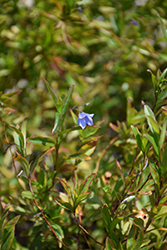It's all about ...
plants

Australian Bluebell Creeper
Sollya heterophylla
Height: 5 feet
Spread: 5 feet
Sunlight:
![]()
![]()
Hardiness Zone: 9a
Other Names: Billardiera heterophylla, Sollya fusiformis
Description:
A climbing evergreen shrub that grows 3 feet as a shrub, but will climb higher with support; pretty, nodding bright blue flowers appear in summer; plant in full sun along coast, or with some shade inland; young plants are more frost tender
Ornamental Features
Australian Bluebell Creeper is draped in stunning fragrant nodding sky blue bell-shaped flowers along the branches from early summer to mid fall. It features an abundance of magnificent deep purple berries with powder blue overtones from late summer to late fall. The fruit can be messy if allowed to drop on the lawn or walkways, and may require occasional clean-up. It has forest green evergreen foliage which emerges light green in spring. The glossy narrow leaves remain forest green throughout the winter.
This plant is primarily grown as an ornamental, but it's also valued for its edible qualities. The oblong sweet berries are most often used in the following ways:
- Fresh Eating
- Baking
- Preserves
Landscape Attributes
Australian Bluebell Creeper is a multi-stemmed evergreen shrub with a more or less rounded form. Its average texture blends into the landscape, but can be balanced by one or two finer or coarser trees or shrubs for an effective composition.
This shrub will require occasional maintenance and upkeep, and should only be pruned after flowering to avoid removing any of the current season's flowers. It is a good choice for attracting birds and bees to your yard, but is not particularly attractive to deer who tend to leave it alone in favor of tastier treats. Gardeners should be aware of the following characteristic(s) that may warrant special consideration;
- Self-Seeding
Australian Bluebell Creeper is recommended for the following landscape applications;
- Mass Planting
- Hedges/Screening
- Naturalizing And Woodland Gardens
Planting & Growing
Australian Bluebell Creeper will grow to be about 5 feet tall at maturity, with a spread of 5 feet. It has a low canopy, and is suitable for planting under power lines. It grows at a medium rate, and under ideal conditions can be expected to live for approximately 30 years. This is a self-pollinating variety, so it doesn't require a second plant nearby to set fruit.
This shrub does best in full sun to partial shade. You may want to keep it away from hot, dry locations that receive direct afternoon sun or which get reflected sunlight, such as against the south side of a white wall. It is very adaptable to both dry and moist growing conditions, but will not tolerate any standing water. It is considered to be drought-tolerant, and thus makes an ideal choice for xeriscaping or the moisture-conserving landscape. This plant should not require much in the way of fertilizing once established, although it may appreciate a shot of general-purpose fertilizer from time to time early in the growing season. It is not particular as to soil pH, but grows best in rich soils. It is somewhat tolerant of urban pollution. This species is not originally from North America..
This plant is not reliably hardy in our region, and certain restrictions may apply; contact the store for more information.
